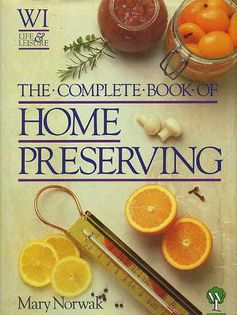Advertisement


The Complete Book of Home Preserving
by Mary Norwak

says
A comprehensive beginner’s guide to bottling, freezing, drying, and preserving all kinds of fruits, vegetables, and meats. Overflowing with simple instructions utilizing basic kitchen equipment to craft over 250 different jams, wines, cured meats, and more, this easy-to-follow guidebook is ideal for creating long-lasting delicacies.
from the publisher
Once upon a time, most houses had their stillroom and larder. The mistress of the house was in charge of the preserving of food and, with the help of her servants, would be responsible for drying herbs, fruit and vegetables; candying and crystallizing fruit and flowers; potting jams and preparing pickles, chutneys and sauces; making wines, cordials and liqueurs; and salting or potting meat. A country household was totally self-sufficient, but preserving was necessary to ensure food supplies right through a year, when animals might have to be killed because of lack of fodder and every scrap of food was precious.
As commercial food processing became more sophisticated, the need for preserving food at home became less essential, although it enjoyed an enthusiastic revival during two World Wars. The development of the home freezer stimulated families to start preserving again by a simple method, which has led to enthusiasm for vegetable and fruit growing and for keeping poultry and in some cases, pigs. This enthusiasm has led in turn to an interest in other methods of preserving to give variety to meals, so that once again, we are experiencing a revival of interest in making jam and pickles, wine-making, herb-growing, meat-salting and smoking. The only method that no longer seems popular is canning, not an easy process for the amateur, and one for which equipment may be difficult to obtain, so that I have omitted it from this book.
This book iswritten with the intentionofhelpingthose who have not been used to home food preserving to tackle the various jobs simply and with pleasure, and I have carried them all out at home with the most basic equipment. M y particular thanks are due to the staff of the Home Food Storage and Preservation Section of Long Ashton Research Station, Bristol, whose work in these fields is invaluable, and to Barbara Hawkins for her work on wine-making.
Most popular
- Original Publisher
- Littlehampton Book Services
- Date of publication
- 1978
- ISBN
- 0706367189
Recommended by
Tristram Stuart
Food waste activist
Advertisement
